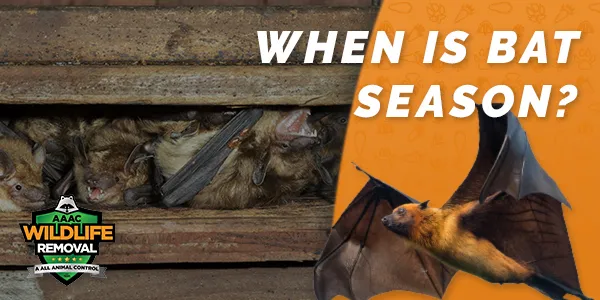Ever wonder when bat season is? It can be a tricky question, as the answer is different depending on where you live. This article will go over the basics of what it looks like and some tips to help you find out when it starts in your area. We’ll also talk about the bat calendar, maternity season, and the regulations that protect bats and their habitats.

When is Bat maternity season
Different species have varying dates of maternity season, for example, brown bat species like the big brown bat and the little brown bat typically are on June 1st to August 15 while evening bats are around April 15 to July 15 and the Mexican free-tail is around May 15 – August 15.
This is the period during spring when female bats give birth to one pup each before returning to winter hibernation. This happens around May or August depending on where your bats live and which species you’re looking at. For example, Mexican free-tailed bats have a very short maternity period of about three weeks total from February through March while other species like grey-headed flying foxes might remain pregnant throughout fall until mid-November just before starting hibernation again!
During this time, it is forbidden to remove bats from homes as flightless baby bats are unlikely to be able to escape if their mothers are excluded and will likely die in your attic or walls. This means if you come across an active colony this early then it is usually best to just wait before doing any bat abatement procedures.
When are bats active?
It is the period between March and November in the Northern Hemisphere. This means that it is usually wintertime in Australia, South America, South Africa, Asia, and Europe when North Americans are able to see them active at night during their summer months.
What do bats do for mating season? Well it depends on the bat. Some might mate earlier or later than others depending on what part of the world they live in as well! For example, this time of year (early spring) is one of the most common times for mating among many species since baby bats typically emerge between April and June after being born around February-March from hibernation. During these two months, females will stay close together while giving birth to one pup each before moving back into hibernation.
Solitary and colonial bat species
There are two types of bats: solitary and colonial. Solitary species are those that tend to fly alone when looking for a mate, food, and shelter. Colonial species, on the other hand, congregate in large numbers. Most of the bats we see on attics and in our backyards are colonial.

Bat calendar
Bats typically follow a pattern of hibernation during winter and then mating around springtime. When the climate starts to warm up or get colder again depending on the species, they will fly off to meet up with others of the same species for mating season. This is when most exclusions and control measures are necessary, as babies will soon be born and the bat colonies will have to find a new roosting site in order for everyone to survive.
Understanding what time of year it is where you live helps immensely when planning how to handle a situation involving bats living in your home! If a bat colony has taken roost inside an attic or somewhere else in your home during bat maternity season then it is best to wait until it’s done before attempting bat exclusion. This allows you to avoid any young bats getting orphaned and dying in your walls or attic.
Here’s what a year in the life of bats looks like:
- January – Winter hibernation – bats are in a state where their breathing is slowed and metabolism and body temperatures are lowered in order to conserve energy.
- February – Still in hibernation, however fat reserves by now are running low.
- March – Some begin coming out of their caves to find food as it gets warmer.
- April – Most have gone out of hibernation by now and are very active and very hungry, they’ll be out foraging for food every night.
- May – Mother bats are now forming bat maternity colonies and searching for a roosting site
- June – Baby bats are born. Adult bats are consuming large amounts of insects.
- July – Mother bats feed and take care of their pups.
- August – Six-week-old pups can now catch bugs by themselves and the females are leaving the roost to find males for mating.
- September – Mating season! They are now also consuming large amounts of food to build fat stores in preparation for the winter.
- October – Still more mating. They’re also looking for hibernation sites now. Some periods of inactivity (torpor) to conserve energy.
- November – Longer periods of torpor as insects are getting harder to find. Some have started hibernating.
- December – Winter Hibernation.
Bat roosting season
Bats typically choose a safe, secluded place in which they can spend their days sleeping away from predators during summer months like attics or under roof tiles. These places are commonly referred to as “roost sites”. When it comes time to give birth female bats prefer larger areas where there is space for them all such as buildings and attics!
Roosts can be found inside structures like old buildings or under bridges, as well as outdoors in trees and other structures that provide shelter from wind, rain, sun, and cold temperatures! Roosts outside are more easily accessible by homeowners who want to remove indoor bats and clean up bat poop in the attic might have no choice but to call an expert if they don’t know where exactly the entry points are located on their property. AAAC Wildlife Removal wildlife technicians are experts in attic decontamination, ensuring that your family doesn’t fall prey to one of several life-threatening bat diseases.
Bat Season and the law
Bats are a protected species. Federal law and many state laws make it illegal to exclude bats during the maternity season. So if you have them in your attic, for example, the law protects them from being removed by live exclusion or other means of forceful eviction. This is necessary in order to protect these creatures who are more valuable than most people realize!

Why are bats protected?
Bats are very important to the environment and the ecosystem. They pollinate plants and disperse seeds. They are also a natural pest control – eating insects that are harmful, including mosquitoes which spread diseases like the Dengue and West Nile Virus. They also eat crop-destroying insects like beetles and can prevent farmers from using pesticides on their crops.
Their populations have been steadily declining because of deforestation and a problem called “white-nose syndrome”. It is estimated that nearly a third of the current population of all bat species in America has declined. That’s why it is extremely important to protect these creatures during their maternity season. If you have them roosting inside your home or property then it’s usually best to wait until after this time period before taking action, otherwise attempting removal might result in fines or jail time.
Having these winged mammals in your home isn’t as scary as it sounds, if you have one or two that’s not even something to worry about because there is no reason for them to be inside all year long unless they’ve been attacked by an animal like a hawk or owl which can cause injuries such as broken wings. Often a good catch and release will do the trick.
Otherwise, these creatures will only enter homes during certain times of the year when their survival depends on it – maternity season! If you happen upon bats while cleaning out your attic you can contact us and we’ll send someone to assess the situation for you.
Professional Exclusion Services
Bats are extremely beneficial to the ecosystem and environment. That being said, they can be a nuisance when you have them living in your home or attic! Exclusion shouldn’t be conducted during the maternity season, especially without consideration by wildlife removal professionals. Please contact AAAC Wildlife Removal if you need any help. We’d love to assist you!
Conclusion
As you can see, there are many seasons in the life of a bat. Bat maternity season is an important part of their lives and they need to be protected during this time. This is also a critical time for a baby bat – every mother needs to be able to find enough food so she can support her baby, as well as gain the extra fat reserve in preparation for the coming hibernation. If you have bats around your home or office and want them removed without hurting them, contact us!
The most important thing is that these creatures are excluded safely and humanely so they don’t suffer any injuries or harm during the process – which may mean having to hire a professional wildlife removal service such as ours! Call us today if you have questions about these amazing creatures!
Originally published on https://aaacwildliferemoval.com/blog/bats/when-is-bat-season




